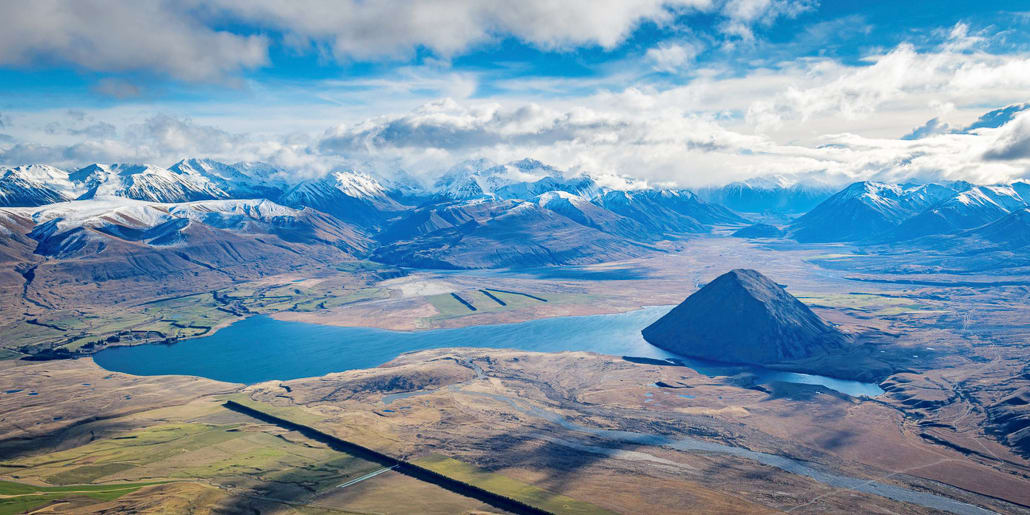Mike Yardley unveils the charm of Lake Heron Station — a high-country retreat blending history, hospitality, and stunning landscapes.
Deep in the golden heart of the Ashburton District, the mountains rise to meet you. Two hours’ drive from Christchurch, I turned off the inland scenic highway at Mount Somers, bound for Lake Heron Station. The sealed road ends with the historic Hakatere buildings, but the sense of heritage in these parts runs deep. Turning off at Hakatere onto the graded gravel road to the lake, I’m rolling through a wide open basin of golden tussock and matagouri, bracketed by high, glaciated mountain ranges.
Lake Heron Station is a magnificent high-country merino station that’s been a going concern for the Todhunter family since 1917. The original Lake Heron run was first established in 1857 before RC Todhunter purchased the station 60 years later. Today, great grandson Philip and Anne Todhunter run the station, with merino wool remaining the mainstay, alongside the alluring hospitality venture. They are truly exceptional hosts, with that quintessential air of authentic, disarming and charming high-country hospitality.
Under a vast blue sky canvas, serrated by the soaring peaks of the surrounding purple mountains, Philip treated me to an illuminating 4WD farm tour across his vast, undulating backcountry realm, spanning 19,600 hectares and boasting 11,000 merino sheep. Family farm dogs, Patch and Jan, came along for the ride. History runs deep at Lake Heron. To the west of the sparkling Cameron River, which tootles through the valley from Lake Heron to the upper Rakaia River, Philip pointed out the glacial lines conspicuously grooved into the hillsides above the Cameron. They denote the towering height of the Rakaia Glacier before it retreated into oblivion at the end of the last ice age.
Five original station huts still stand stoically on the sprawling property, cherished totems of the past. These shelters were originally built to assist with the mustering of sheep. The names of musterers from yesteryear can be seen etched on the hut walls. Today the huts are still used for accommodation, like the New Hut, which was built in 1923 and is still the base for the 4-day autumn muster, in addition to accommodating guests seeking a backcountry escape.
The autumn muster involves a team of 6 men and 18 dogs, ushering thousands of sheep down to the lower country before the winter snows arrive. The country is too steep for horses or motorbikes and the shepherds move by foot with their teams of working dogs, scrambling across scree and climbing up to 800 metres a day. I was constantly stunned to see just how high these hardy sheep roam, easily mistaken for rocky outcrops on the slopes, before they suddenly move.
Growing wool is still a major focus of the farming operation, with a large portion of the wool clip processed into active outdoor and leisurewear for Icebreaker. Angus cattle and lamb production also complement the farm business, too. Over a delicious dinner in the family homestead with Anne, Philip and their teenage son Oscar, we actually worked out that Lake Heron Station is the same size as Macau — or Paris.
The wealth of activity options at Lake Heron Station is head-swirling. The vastness of the station means you can choose from a wide range of walking and hiking options. Anne and Philip will equip you with maps and directions, whether you’re up for a short and sweet walk or a full-day slog. Mt Sugarloaf is a prized hike — this is a roche moutonnée, a rock formation shaped and smoothed by the passing of a glacier — not dissimilar to Lake Tekapo’s Mt John.
The jewel-like brilliance of Lake Heron deserves a dip. The lake mirrors everything around it, as flat as glass, rippled only by the surface trails of paddling birdlife. Life jackets, a small dingy and kayaks are available from the station, as are fishing rods. Lake Heron is well stocked with trout, so why not try your luck for the catch of the day?
Another riveting option is to take to the skies with Philip, a commercial pilot with four decades of backcountry aviation experience both in helicopters and fixed-wing aircraft. To immerse yourself in the glory of Lake Heron Station’s surrounding landscapes, take a 40-minute flight featuring the mountainous high country merino stations of the Upper Rakaia and Rangitata Valleys, including the glaciated peaks of the Arrowsmith Range and Mt Sunday, the site of Edoras in Lord of the Rings.
On-site accommodation exemplifies the station’s deep commitment to repurposing and enhancing what their forebears left behind. Restoring station buildings for guests to enjoy underpins the accommodation offerings of Lake Heron Cottage and the New Hut, which can sleep up to six and 12 guests, respectively. I bedded down in the newest offering, the Fisherman’s Hut, which Philip tells me was a “Covid project”. Designed for a couple, this romantic hut is a fully self-contained one-bedroom unit with a stylish kitchen, laundry, living area and ensuite bathroom. As with all their accommodations, it keeps the faith in the high-country aesthetic. Snugly ensconced in cottage comfort, huddled beneath those purple mountains, a chandelier of constellations carpeted the inky sky as I drifted off to sleep, in the heart of hill country.
Lake Heron Station is a revelation, underpinned with affordable high-country hospitality in excelsis. www.lakeheron.co.nz

















0 comment
JOIN THE CONVERSATION
Read and post comments with a
Newsroom Pro subscription.
Subscribe now to start a free
28-day trial.